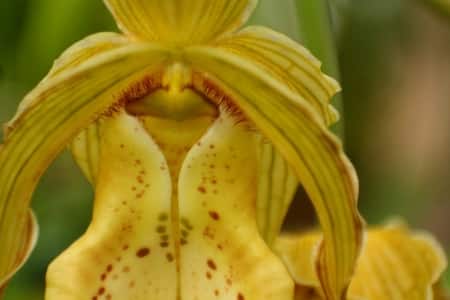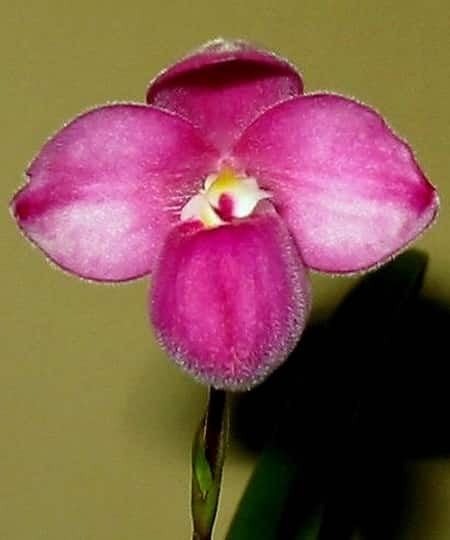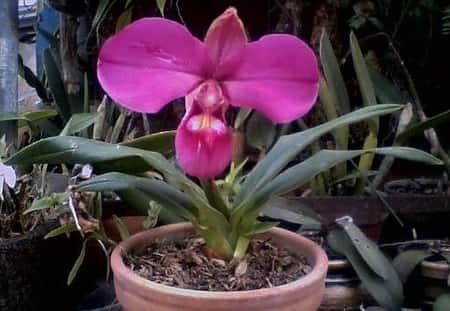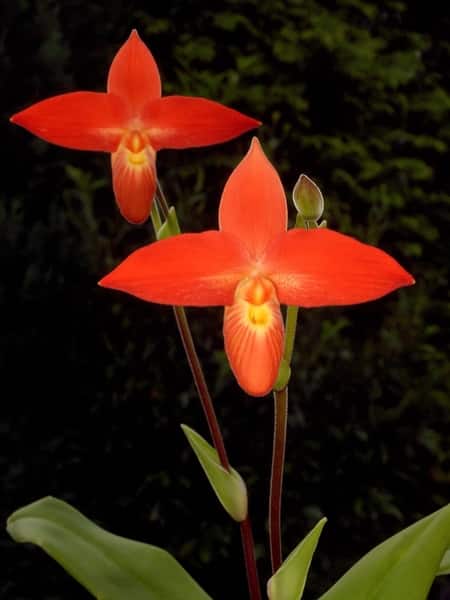Phragmipedium orchids are just one genus of the divisions of the Cypripediaea, most commonly grouped together in one big bundle, known as the Lady Slipper Orchids. To form this vast group, the Phragmipedium orchids grouped together with both the Paphiopedilums and the Cypripediums. Yet, they aren’t the same.
The main differentiation in these three orchid genera is the location on the map. Phragmipediums are cultivated in the western hemisphere, anywhere from southwest Mexico, down into Central America and thriving in the northern and middle parts of South America. Their “cousins”, the Paphiopedilums, are grown mainly in Asia, and sometimes referred to as the Asian Lady Slipper. The third and last group, the Cypripediums, are grown in northern temperate climates.


This article will only focus on the Phragmipediums, grown in the Americas. The name has caught on, and sometimes the Phragmipediums are called the American Lady Slipper.
There are 28 species of this orchid in the Phragmipediums genus, and you’ll learn the basic distinction between these in this article.
First, let’s divide them into smaller more manageable classifications. Please note that this article is not a cultivation guide, specific to each one. It is more a familiarization and “get to know you” type article.
The 23 types of Phragmipedium orchids are classified into 6 basic categories or subdivisions, which are:
Phragmipedium,
Himantopetalum,
Platypetalum,
Lorifolia,
Micropetalum,
and Schluckebieria.
Phragmipedium orchids are distinct in their care culture amongst these 6 subdivisions. Each type will represent a distinct culture and environment in which the Phragmipedium best thrives.
6 Subgroups aren’t the only way to categorize Phragmipedium orchids. The other classification with only 2 types is observed from the climates Phragmipedium orchids thrive in, either wet or dry.
If you are a new orchid grower, maybe this second division is enough, because by dividing the Phragmipediums into only 2 big subdivisions, you cover all main concerns for culture and care. The division more commonly used, into 6 types, is more comprehensive but doesn’t sway too much in terms of care.
There is another difference between the Phragmipedium and the Paphiopedilum, and that is in the ovaries of the blossom. Phrag means three chambers, as the ovary has three distinct chambers, unlike the Paphiopedilum. They don’t have pseudobulbs, but the stem forms leaves that fan out to the sides, giving them the name “fans”.
The central flower spike will emerge from the central point, called an apical meristem. This can sometimes be confused with a terminal spike as Phalaenopsis orchids sometimes produce. The difference is that for Phrags this is normal and doesn’t indicate a problem. Phals, on the other hand, will produce their flower spikes from the sides of the stem, not from the center.
Let’s look at each type of Phragmipedium more closely to better comprehend how each orchid lives in nature and adapted to better thrive in its specific climate.
List of Phragmipedium Species
| Himantopetalum | Phrag. caricinum Phrag. ecuadorense Phrag. klotzscheanum Phrag. pearcei | Bolivia Peru Ecuador Guyana |
Lorifolia | Phrag. boissierianum Phrag. cajamaracae Phrag. czerwiakowianum Phrag. dariense Phrag. gracile Phrag. hartwegii Phrag. hincksianum Phrag. longifolium Phrag. reticulatum Phrag. roezlii Phrag. vittatum Phrag. hirtzii | Peru Ecuador Costa Rica Panama Brazil |
| Micropetalum | Phrag. besseae Phrag. schlimii Phrag. xerophiticum | Peru Colombia Mexico |
Phragmipedium | Phrag. caudatum Phrag. wallisii Phrag. warscewiczianum | Ecuador Peru |
Platypetalum | Phrag. kaieteurum Phrag. lindleyanum Phrag. sargentianum | Guyana Venezuela Brazil |
| Schluckbieri | Phrag. kovachii | Peru |
1. Phragmipedium section Phragmipediums

 *Please note this is a Phragmipedium fischerii, which is a different category.
*Please note this is a Phragmipedium fischerii, which is a different category. The first group, the Phragmipedium orchids, include 3-5 species (depending on who you reference):
Phragmipedium caudatum,
Phragmipedium warscewiczianum or sometimes called wallisii,
Phragmipedium lindenii,
and Phragmipedium extaminodium.
The first group, the Phragmipedium orchids, include 3-5 species (depending on who you reference): Phragmipedium caudatum, Phragmipedium warscewiczianum or sometimes called wallisii, Phragmipedium lindenii, and Phragmipedium extaminodium.
Quick note: I’ve seen some taxonomist categorize Mexipedium or Xerophyticum in this group as free-loaders, but I couldn’t find a concise placement in writing that placed these last two Phragmipediums here. So take these last 2 with a grain of salt.
These orchids are always epythitic, growing on trees in the open grasslands of the savannah. Grassy swamps… that makes them unique. They’re not rainforest orchids in that they like filtered shade. In fact, they won’t bloom if they don’t get enough direct sun.
The Phragmipedium orchids, with their long droopy petals, will grow in trees scattered throughout the hot, equatorial grasslands. They grow best in the forks of trees that don’t have many leaves. Their long petals adapted to receive higher quantities of sunlight.
Unlike the Phalaenopsis orchids, you can grow these types of Phragmipediums in full sun. They react well to higher light conditions than Cattleyas will and mimic Vandas in terms of light.
The difference between Vandas and Phragmipediums? They won’t adapt to higher humidity. Humidity is still high, (60 to 70%) but compared to other Phragmipedium orchids in the category which will prefer to be submerged on constantly in water, these Phragmipedium orchids don’t like soggy roots.
Putting it nicely, the don’t like to get their feet wet all the time. They still like humidity, so don’t get me wrong. They just don’t like as much as the other species in this genus. Thus, these are also considered dry orchids.
You will need a humidifier to grow Phragmipediums. If you don’t have one, I recommend this one (Affiliate Link) that I bought on Amazon after researching tons of products. For my tiny home office, it does the trick.
that I bought on Amazon after researching tons of products. For my tiny home office, it does the trick.
In any case, I recommend reading this article about humidifiers to select the one that would best fit your preferences and environment because my needs aren’t the same as yours. The article explains the different types of humidifiers and which one is best suited for you.
2. Phragmipedium section Himantopetalum
This is the first group of wet orchids. These orchids can be submerged for short periods of time, as they prefer to grow next to rivers, waterfalls, streams, and brooks. They are native to Venezuela and Guyana, in the lower mountains of the Andes.
They are not epythitic but grow on the rocks near water sources. The leaf litter and soft clay are rich in organic material is especially important, since they send out long, string-like roots down from the rocks and into the streams below them. That is why it’s important to keep them a bit more fertilized than other orchids.
Sometimes when the water level rises, these flowers can live partially submerged. The river beds extrapolate their limits and this orchid doesn’t mind at all. The extremely soppy roots can be waterlogged all the time.
What they do not like is bad water quality. They need water but keep the source as clean as possible. Tap water just doesn’t hit the mark. Rainwater, well water, reverses osmosis water are the best for this orchid since they need the purest quality water there is. I use distilled water, since in Kansas my tap water is horrendously alkaline.
The species in this groups are the P. caricinum, P. christiansenianum, P. pearcei, P. klotzscheanum, P. richteri, P. tetzlaffianum. Probably the most common is the P. pearci, because of its smaller blossom, with an intriguing green color and long twisting petals.
A common occurrence here is the augmented size in the rhizome, which also occurs in the Phrag. Besseae below. All other Phragmipediums have reduced rhizomes, compared to other orchids.
3. Phragmipedium section Lorifolia
This is probably the biggest group or division of Phragmipediums. Species in this group include: Phragmipedium longifolium, Phrag. longifoliumvar. roezlii, Phrag.longifoliumvar. hartwegii, Phrag. longifoliumvar. Hincksianum, Phragmipedium boissierianum, Phrag. boissierianumvar. czerviakovianum, Phrag. boissierianumvar. reticulum, Phragmipediumhirtzii, Phragmipedium vittatum, and Phrag. Dariense.
I did find a few free-loaders in this group also. It all depends on who you read, but others might include Phramipedium minutrum, chapadense, baderi, gracilie, and Brasiliense in this group also. Brasiliense was only added in 2003.
These also are wet orchids, preferring to always stay in wet feet conditions. In fact, if you grow these, keep a bowl of water (like a humidity tray) under them but actually let their pot sit in the bottom inch. There is no need to worry about root rot in these orchids (if you keep your fan on) since they are more adapted to always be in wet conditions and climates.
4. Phragmipedium section Platypetalum
Image Credit: “File:Phragmipedium peruvianum.jpg” by Phragper is licensed under CC BY 2.5

Phragmipedium sargentianum, Phragmipedium lindleyanum, Phragmipedium lindleyanumvar, and Phragimepdium kaieteurumare all part of this categorization of the Phragmipedium orchids.
*Please note the picture is not a Platypetalum, but it is still a Phragmipedium.
They are considered wet since these can be found near waterfalls with high humidity. The only difference in this group is there uniquely shaped petals and sepals and the light conditions.
As for basic care, their care is like the other Phragmipediums. Let’s take the P. sargentiam for example, found in the coastal mountains of Brazil. It displays a huge flower when it’s a mature adult, which is totally impressive. Another name for this orchid is the Sargent’s Phragmipedium. It has an enormous blossom, (did I say that already?) ranging in the 4 inches (10 cm). They are not as high-altitude dwellers, preferring lower altitudes near the coast, of around 650 to 900 meters.
If you have seen pictures of the Christ statue in Rio de Janeiro, then this is the growing condition you should imagine. The mountains in the background around the coast aren’t very high, (when I lived there, I para-glided over the coast and I had to run off the side of the mountains, so to me, it was extremely high…LOL), but not near anything in other mountain ranges.
In these warm but humid mountain ranges, the Sargent’s Phrag is grown under the shade of huge overhead ferns. This makes their light conditions a little lower than most others in the Phragmipediums.
On a personal note, they make beautiful, award-winning pictures in their natural habitat.
Humidity is so high, water droplets drip off these petals all day long. When the blossom opens in later winter and early spring, a reddish-purple blossom emerges. The flower spike on these is what first grabs your attention, growing anywhere from 2 to 4 feet (60 to 120 cm) long.
5. Phragmipedium section Micropetalum
Image Credit: “Phragmipedium besseae Orchi 008.jpg” by Orchi is licensed under CC BY-SA 3.0

Composed of
P. besseae,
P. besseae var. dalessandroi,
P. fischeri,
P. schlimii,
P. lbiforum,
P. andretae,
P. flavum,
and P. dalessandroi,
the Phramipediums section Micropetalum have flowers that resemble a velvet coating.
The name of this group comes from the smaller leaf size in comparison to the other Phragmipediums. They still are quite large, don’t get me wrong, but considerably smaller than others. The flowers are smaller also.
The same growing conditions for other orchids apply to this “wet” group, but their light preferences will be a little lower than the rest, and they’ll grow in cooler temperatures. As mentioned before, most Phragmipediums will thrive in high light conditions. Not these.
The Besseae is the most common with its deep red to spotted orange color. If you don’t provide the light conditions it likes, even the lower ones, the blossoms might come out toward the pink side. If you keep the light requirements correct, the blossom is deep and vibrant red. The flavum types are just a slight modification in the besseae, and a deep vibrant orange takes over, substituting the red. Both are vibrant colored orchids, stunning in their flowering.
I hear a lot about aquarium orchids, and these would be an excellent candidate. I have not yet tried this method, but if you suspended the micropetalum above the aquarium and have only the tips of the bottom roots of your orchid in the tank, your orchid will absolutely love you (theoretically). The water has to be flowing though, so don’t place this in a beta or goldfish bowl with stagnant water.
Phragmipedium besseae is native to Ecuador and found in altitudes of 800m to 1,500m high. This translates into a slightly cooler growing temperature.
The leaves on this orchid are almost ruler length, both in size and length (13–30 cm long, and 2–5 cm wide). The leaves are not full, dark, deep luscious green, but a dull green, and are naturally overturned. They will blossom anywhere from having only 1 flower spike to having around 6, opening sequentially on a flower spike that is around 50 cm tall.
Phragmipedium besseae don’t live as long in nature according to The IUCN Red List of Threatened Species, printed in 2016, suggests maybe 7 to 8 years. This is suspected to be caused by deforestation in the area, logging, and wood harvesting. Unfortunately, the continuing decline of Phragmipedium besseae found in natural habitats rise.
printed in 2016, suggests maybe 7 to 8 years. This is suspected to be caused by deforestation in the area, logging, and wood harvesting. Unfortunately, the continuing decline of Phragmipedium besseae found in natural habitats rise.
In the guide mentioned above, they classify the Phragmipedium Mircropetalum as terrestrial, but if you are going to pot them, don’t use the traditional terrestrial mix. They much prefer an epithytic type of potting medium, since they have a layer of leaf litter to grow through before they reach the rocks or soil.
In nature, Phragmipediums will grow in the most varied places: volcanic clay (wallisii and boissierianum), submerged in streams (longifolium, ecuadorense, pearcei, and klotzscheanum) on rocks (mexipedium and xerophyticum ) to even the forks of trees, (cauditum). You need to find what works with you and your environment, so you know how to water best. This goes for most all Phragmipediums. I keep mine in orchid bark, perlite, charcoal, and, just double up on sphagnum moss, keeping the pots in 1 inch of water.
6. Phragmipedium section Schluckebieria
This lonely category has only one orchid in it: P. kovachii. Now out of all you’ve read in this guide about watering, and preferring a more acidic water, ALL THAT does not apply to this orchid. You can use a more alkaline water, since it can’t live in low pH’s very well.
Maybe that’s why it got an exclusive group all to itself.
It is also considered a wet orchid. I won’t say too much about this orchid, because in all honesty, this article  that has gorgeous pictures says it all. I didn’t write it, but I wish I could met the author. It’s a mouth-dropping article that kept me turning the pages (ok, kept me scrolling… but you get the point). Priceless, really. Seriously, read that article.
that has gorgeous pictures says it all. I didn’t write it, but I wish I could met the author. It’s a mouth-dropping article that kept me turning the pages (ok, kept me scrolling… but you get the point). Priceless, really. Seriously, read that article.
Further Reading Suggestions:
Don’t just take my word for what is written here. Continue researching other articles about Phragmipedium Classifications, because everyone has a different point of view and unique techniques that work for them. Here are a few other articles from other websites if you’d like to continue your research on orchid care for Phragmipediums:
In this 4 page PDF that you can download, the American Orchid Society has better explained the differences in the types of Phragmipediums in detail for judging. If you want to know more about your type of Phragmipedium and if it would win an award, I highly suggest looking at this PDF.
that you can download, the American Orchid Society has better explained the differences in the types of Phragmipediums in detail for judging. If you want to know more about your type of Phragmipedium and if it would win an award, I highly suggest looking at this PDF.
In this newsletter from The Journal of Canadian Orchid Congress, there is an extensive section about Phragmipediums. It is well worth the read, and you can download it here .
.
This last recommendation is more of a pass-time than an actual term paper, since it is a list of all the accepted names in taxonomy for the Phragmipedium orchids . According to them there are 27 Phragmipediums that are acceptable, and not 23 like I stated. It’s interesting to see what species your orchid is from and how it relates to others in the Phragmipedium group.
. According to them there are 27 Phragmipediums that are acceptable, and not 23 like I stated. It’s interesting to see what species your orchid is from and how it relates to others in the Phragmipedium group.
I had fun snooping through their site and typing up of every single plant I know the name of in their search engine. Again, it’s not an article, but more of a database.By now, you’re probably thinking about purchasing a few more orchids. Am I right? One of the biggest problems I have in my home office is space, since I really don’t have that much. Every inch counts. Here are a few suggestions that I recommend that maximize the space in my home office, but they really could be used anywhere inside or out.
If you need a plant stand and have plenty of natural light, take a look at these precious stands, perfect for orchid growing.
These 3 stand alone plant stands are extremely sturdy and hold up those extra pots with style. If you click on the picture or the name, it will take you to Amazon to check out the price.
Sturdy Iron Plant Stands
If the above is not your style or preference, and but you still have tons of light and space by the window, these plant stands will set you up before you have to invest a lot more money in a more in a larger set up.
These stacked stands are great to adjust to your own available space and are perfect for outside porches.
Benches as a Plant Stand
If you don’t have any “decent” east-facing windows that are perfect for morning sun, then I suggest looking at this article I wrote about plant stands which will have to be paired with artificial lighting. In that article, I explained what to look for in a good stand and how to get the best style for your money. The grow lights I use  (Affiliate Link)
(Affiliate Link) , do quite well to supplement the lack of natural lighting. All my orchids are on a plant shelf under them and doing quite nicely.
, do quite well to supplement the lack of natural lighting. All my orchids are on a plant shelf under them and doing quite nicely.
Don’t Stop Learning!
If you want to be included in more information and get a 14-page fertilization guide, please sign up for my newsletter. I don’t spam, but send emails out bi-monthly with some curious topics of interest. If you want more information, click here to go to a specific page on this website where I explain it more in detail.

Also, if you are looking for an orchid journal to keep your notes specifically about orchid care, check out my 2 solutions for that on this page. If note-keeping isn’t your thing, then there is a free excel spreadsheet that you can download. Click here for more information on how to do that.
If you subscribe to my newsletter, I will send you a 14-page guide on the main tips of orchid fertilizer. It is downloadable and you can print it out on your computer. I designed the guide to double up as a coloring book, just to make it fun.
I wish you all the best in your orchid growing!
Happy Cultivating!



